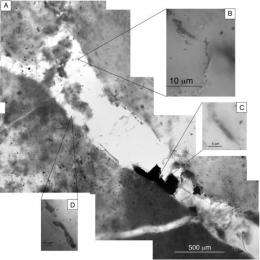February 21, 2011 report
Oldest fossils ever found may not be fossils after all

(PhysOrg.com) -- A rock formation in Western Australia was the site of great excitement a couple of decades ago when it revealed evidence of the oldest fossils of bacteria ever found, but a new study casts doubt on those findings.
The Pilbara craton in the northwest of Western Australia is one of only two remaining areas of pristine Archaean (3.6-2.7 billion years old) crust remaining on Earth. (The other is is Kaapvaal in South Africa.) The region is renowned for its deposits of apex chert, a fine-grained cryptocrystalline material rich in silica and featuring microfibrous sedimentary rock. The Pilbara Apex Chert has been dated at 3.5 billion years old and contained what was thought to be filaments of the oldest fossilized cyanobacteria in the world.
There has been some debate about whether or not the deposits were really fossils since the formation is now believed to be a hydrothermal site rather than the remains of a shallow sea floor. The ancient remains of hydrothermal sites are sometimes mistaken for fossils.
Assistant professor of paleobiogeochemistry, Dr Alison Olcott Marshall and colleagues from the University of Kansas in the US decided to settle the debate by analyzing new samples of the Apex Chert. They cut small, 300 micrometer sections of the debatably biological filaments, but for the first time they also cut sections 30 micrometers long to enable more light to enter the samples.
The shorter sections revealed the filaments were actually fractures in the rock, filled with a dark mineral and a light, clear mineral. They used Raman spectroscopy to identify the minerals, which turned out to be hematite (dark) and quartz (light), neither of which are biological in origin.
Martin Brasier, of the University of Oxford, UK, who first proposed the formation was hydrothermal, said he was not surprised at the new study’s results since in 2002 his team found a fossil known as the “red banana,” which led them to suggest many of the filaments identified as fossils were hematite.
Olcott Marshall's study also identified a carbonaceous material in the rock surrounding the filaments, and this material could be biological in origin. Dr Olcott Marshall thinks this material might have been sampled accidentally by previous researchers and led to them identifying the filaments as biological.
More information:
Haematite pseudomicrofossils present in the 3.5-billion-year-old Apex Chert, Craig P. Marshall, Julienne R. Emry, & Alison Olcott Marshall, Nature Geoscience (2011) advance online publication, doi:10.1038/ngeo1084
via: Nature News
© 2010 PhysOrg.com



















